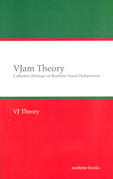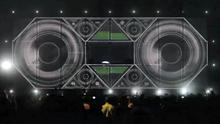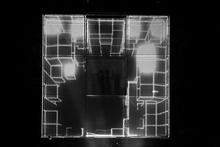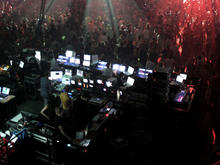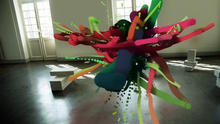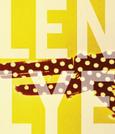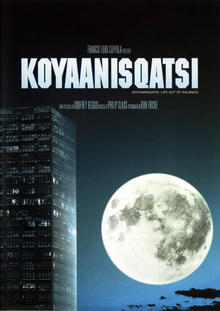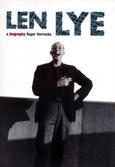1024 architecture
(*2007) is a company created by Pierre Schneider and François Wunschel, both co-founders of the Exyzt collective. 1024 architecture focuses on the interaction between body, space, sound, visual, low-tech and hi-tech, art and architecture.
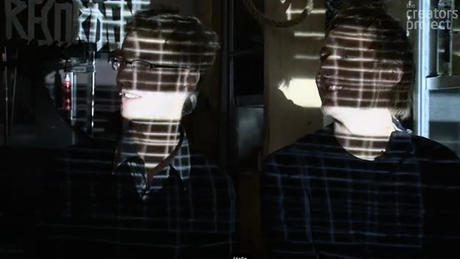
After a professional spin-off and name change, the newly coined 1024 architecture decided to focus on pushing the boundaries of architecture with three-dimensional light projections - and their sound-sensitive installation Perspektive Lyrique, a commission for the 2010 Lyon Festival of Lights, remains a groundbreaking project in terms of implementation and interactivity accomplishments. Here, visitors were encouraged to sing or speak into a microphone - placed in front of a building - and the house itself, a former music theatre, would react to their input and come alive. Behind the scenes, or rather within the software, the team used an in-house algorithm to analyse the respective sound input and then translate it to a dynamic visual output. To this end, each note was assigned a unique “characteristic“ and “behaviour“, or so François Wunschel explains. “Using sound is a very direct means of interaction; there is no real need to explain it to the audience, it is very easy to understand. As an architect, the real challenge to projection mapping is to be able to move beyond the intial architecture (the canvas) while still retaining its characteristics.” A die-hard gamer, Wunschel likes nothing better than to incorporate gaming technologies into his projections, e. g. by using a joypad to control them like video games.
Source: mb!
When the architecture world was still using 2D and 3D animation techniquesto represent their projects, Pierre Schneider and François Wunschel were busy reappropriating them for design and analysis, until the moving image itself became their sculptable raw material.
Coming from a generation for whom associating ephemeral with perennial is no longer a paradox, these two ex-members of the collective eXYZt—E for energy, T for time—have hardcoded into their DNA the immersive power of sound. As videomapping pioneers, they have been building passageways between digital art and recyclable buildings since 2005. And they must be at least a lightyear ahead for CERN to ask them to simulate the subatomic experiments of a particle scanner…?
Their name defines their field of activity—between physical and digital architecture, 1024 corresponds to the standard resolution of a screen or video projector (1024 or 512x512 pixels).
When you make digital art, you need to know how to take apart computers, to be a bit of a VJ, and an architect while you’re at it, in order to better understand the space, especially when you’re interested in mapping.
Mapping? Augmenting an object or a space through video projection—adding an extra dimension that is commanded by images, such as notions of movement or texture, thus altering our perception of reality.
After graduating from École Nationale Supérieure d'Architecture de Paris la Villette, Pierre Schneider and François Wunschel chose as their subject scaffolded residential buildings that they could transform according to their needs; in parallel, they explored visual arts and various media related to moving images.
In architecture, the dynamics, changes, development and especially transformation process of a building were very hard to relate in the form of a map, mock-up or still images. So we used animated films for our presentations—3D, modeling clay or stop motion—to speed up time and show its impact on the building. It was at the Mapping Festival in 2005 that they discovered the world of VJing, even before they realized that videomapping would become a discipline in itself. (...)
Breaking away from eXYZt in 2007, they create 1024 architecture to sign Square Cube, an installation for Étienne de Crécy, one of the figureheads of “French touch electro fresh”. The 6x6-meter structure made for Les Transmusicales de Rennes tours around the world, but it’s the Boom Box that truly reveals their identity to the public, with its giant 16x8-meter 'Ghetto Blaster' created especially for La Nuit Blanche d’Amiens in 2008. It’s simple and efficient: a symbolic image of the dance machine is mapped onto a scaffolded structure, then gradually whirls into visual abstraction. With a game console controller used to interface with the “boom boxer”, homemade software developed to manage interactions between image and sound and a few extra strobe lights, thousands of people dance in the streets of Enghien-les-Bains a few years later in 2011, chanting “Every-body is upset!” to a tempo set by a DJ perched in the virtual tape deck in the middle of the lake of this popular off-site playspot. (...)
In collaboration with Garage Cube, the Swiss organizers of Mapping Festival and developers of the VJing software Modul8, 1024 architecture developed MadMapper, an engine conceived specifically for video mapping, which consists of repositioning video elements in space. We wanted to capitalize on our plug-ins with programmers of the highest level. Commercializing the program [sold for 299 euros per licence] financed our ongoing software development, while creating an emulator for the field. Algorithms that automatically reposition the point of view or scan a space in 3D with a video projector are among the technical developments that François takes the time to upload online in the form of tutorials for other videomappers, either novice or converted.
Source: Digital Art International
